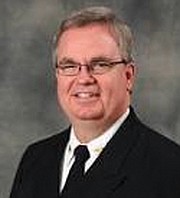Ambulance charges may dramatically increase
$600 trips to medical centers could more than double
Jeremy M. Lazarus | 3/23/2023, 6 p.m.
City Hall is pressuring the Richmond Ambulance Authority to nearly triple its charge for transporting patients to hospitals or other treatment centers based on a consulting firm’s recommendation, the Free Press has learned.
The RAA currently charges $600 for a transport, but might have to boost it to a record $1,625 a trip.
In addition, Mayor Levar M. Stoney and his administration are pushing the RAA to start billing for currently free services it provides after receiving a call for service. That includes performing health tests, such as electrocardiograms for heart conditions and blood glucose tests for diabetes, and administering medications.
RAA, which currently only bills when it transports a patient, is not commenting on the proposed charges that could impact how much people might have to pay for an ambulance ride.
Chip Decker, RAA’s chief executive officer, said the prospect of such rate changes remains “speculative at this point in the budget process.
“The RAA is continuing budget discussions with city leaders and examining the recommendations made by consultants following a review of RAA’s operations,” Mr. Decker continued. “Our goal during these discussions remains the same, and that is providing the best medical care possible for city residents.”
Some evidence of the pressure can be found in the proposed 2023-24 budget that Mayor Stoney presented to City Council on March 6.
The budget plan provides for RAA to receive $4 million in subsidy for the third year in a row — well short of what RAA reported in 2021 would be required to maintain financial soundness.
However, the Stoney administration plan includes, for the first time ever, a $1.4 million contingency line item for RAA that could be withheld, the Free Press has been told, if RAA declines to increase its charges.
Lincoln Saunders, the city’s chief administrative officer and a member of the RAA board, has advised the council that the contingency funds would be available, if needed, to offset inflationary pressures on RAA.
The contingent nature of the item, though, sends a clear message from the administration to RAA that a failure to follow the recommendation to generate more revenue could have financial consequences.
The higher cost for transport and the new charge for medical services are among the recommendations for RAA improvement that have emerged from a report a Washington-based consulting firm, the Robert Bobb Group, led by a former Richmond city manager.
The report was formally presented to the council at a meeting that followed the mayor’s budget presentation.
Mr. Bobb was involved in the creation of RAA as a public utility in 1991 during his tenure as the city’s top executive. He advocated for the RAA’s development as the antidote to rising public dissatisfaction with private ambulance companies’ responses to heart attacks, gunshot wounds and other emergencies.
The RAA through the years has secured recognition nationally and internationally for its work, garnered 95 to 99 percent approval ratings from residents it serves and become one of the few ambulance services accredited by the two major standard-setting agencies.
The city always has provided a subsidy
to the RAA to fill the financial gap between the cost of service and the revenue collected, but now appears determined to either hold the amount steady or to reduce it.
Since the 2021-22 fiscal year, the subsidy has been set at $4 million, even as RAA has argued it needs a higher amount to fully cover costs.
During budget deliberations in 2022, the Stoney administration cut a deal with the RAA to enable the city to cut its subsidy from a previous $5 million a year to $4 million.
Under the deal, the city agreed to buy 14 replacement ambulances over two years for $3.5 million. In exchange, the RAA agreed to shift $3.5 million it had saved to buy ambulances to support operations.
In the 2023-2024 budget proposal, the administration has proposed to keep the subsidy at $4 million, but did not offer to continue to buy ambulances for RAA. Instead, the administration is looking to RAA to generate more revenue by increasing the charge for transport and adding a new charge for medical services.
Even if the RAA complies, it remains unclear how much new money might be collected.
RAA receives about 56,000 calls a year for service, but only 70 percent or 39,000 result in billable transports.
Payments often fall below the RAA’s full charge, according to the Bobb Group’s report.
The report found that 63 percent of the revenue RAA received from transports in 2021 came from government insurance
programs, Medicare and Medicaid, which pay less than RAA’s retail rate of $600. Medicare pays $300 to $500 per trip, depending on the level of service, while Medicare, a federal-state program, pays $175 per transport, a report shows.
Private insurers generate only about 14 percent of RAA’s report. Most insurers set a certain amount in their policies to cover ambulance service, leaving policy holders to make up any difference between the coverage amount and the billed charge.
It is unknown whether insurance compa- nies would agree to increase their coverage amount and how much higher they might go if RAA raises its rate.
The annual financial reports that RAA submits to the city reflect the reality that billable amounts are not the same as collected revenue.
In 2021, RAA billed $28.1 million for transport services, but collected $14.9 million after contractual adjustments and writeoffs of uncollectable charges, the financial report states.
In 2022, RAA billed $25 million, but collected $13.5 million after adjustments, the report states. Council members did not object or express any dismay about the increase in charges the Bobb Group recommended and that the administration supports, including 8th District Councilwoman Reva M. Trammell, chair of council’s Public Safety Committee.
For now, there is only a question mark as to whether the rate changes will go into effect.









